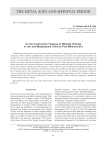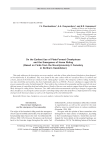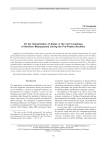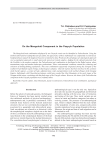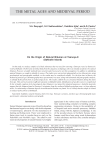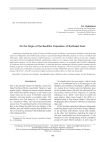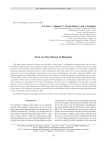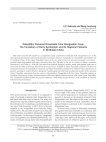Archaeology, Ethnology & Anthropology of Eurasia @journal-aeae-en
Статьи журнала - Archaeology, Ethnology & Anthropology of Eurasia
Все статьи: 524

On the chronological position of Siba culture metal artifacts, Northwest China
Статья научная
This study shows that bronze artifacts typical of the Siba culture (Gansu, China), such as cast convex plaques with loops, open-gap hook earrings with trumpet-shaped ends, and lamellar stemmed daggers, are similar to those from burials of the Late Krotovo (Cherno-Ozerye) and Andronovo (Fedorovo) cultures in Western Siberia, while the socketed celt-adze from the Ganguya cemetery is paralleled by those from Late Krotovo, Alakul, and Srubnaya complexes. Open rings with two opposed cast trumpet-shaped ends, open-gap hook earrings with trumpet-shaped ends, and cast convex plaques with loops, as well as stemless lamellar bronze knives with triangular section along the entire length, synchronize Siba with the cultures such as Munkh-Khairkhan, Late Qijia, Lower Xiajiadian, and Late Glazkovo. Therefore, radiocarbon dates of the Siba culture are confi rmed, suggesting that it falls within the 1800–1400 BC interval. If so, Siba bronze knives with curved spines and I-beam-shaped section of handles, as well as cast convex plaques with loops, can be considered prototypes of Late Bronze Age types of the Karasuk and Irmen cultures. Populations of western China preserved earlier (Seima-Turbino?) traditions of metallurgy, having infl uenced the culture of the mountain-steppe zone of Northern Eurasia in the last third of the 2nd millenium BC.
Бесплатно
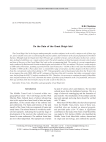
On the date of the Great Shigir idol
Статья научная
The Great Shigir Idol is the largest anthropomorphic wooden sculpture in the world, a unique work of Stone Age art, and a valuable source for reconstructing the material culture and worldview of the ancient population of Northern Eurasia. Although study of it began more than 100 years ago, a number of issues, such as the place of discovery, context, date, methods of exhibition, etc., remain controversial. This article analyses archival documents relevant to the location and time of discovery of the Great Shigir Idol, and on the accompanying finds. The results of a recent comprehensive study conducted by Russian and German archaeologists and scientists in 2014 are outlined. The focus is on the analysis of AMS radiocarbon dates, spanning a period from the Late Pleistocene (~10,500 cal BC) to the Late Mesolithic/Early Neolithic (~6000 cal BC). These dates show a considerable range of variation, and they disagree with those derived from the conventional radiocarbon dating in 1997. Paleogeographic and archaeological data from the Trans-Urals do not support the early (9600–9000 cal BC) estimates of the time of the idol’s creation, but rather correspond to later ones, derived from the AMS 14C analysis conducted in 2014. Therefore, it is necessary to continue the study of Mesolithic sites and paleoclimate of the Urals, determine the nature of primary peat formation at the Ural peatlands, and assess their age and that of the microremains of peat in early cracks in the idol, etc.
Бесплатно
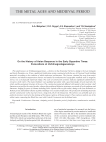
On the history of Asian Bosporus in the early Byzantine times: excavations at Verkhnegostagaevskoye
Статья
Бесплатно

On the time and context of the earliest bronze mirrors in the Northern Pontic region
Статья обзорная
Бесплатно
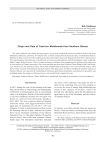
Origin and date of cast-iron moldboards from southern Siberia
Статья научная
The study addresses the dating and provenance of cast-iron moldboards found in Southern Siberia (the Altai Mountains, Khakassia, and Tuva). For the first time, a similar artifact from the Katanda valley, Ust-Koksinsky District, Republic of Altai, is described. The traditional idea that such artifacts date to the Tang epoch (618–907) is unwarranted. New interpretations of inscriptions on moldboards are proposed, indicating ties with the metallurgic center in Qiyang, Shahe County, Hebei Province, China. Certain specimens could have been manufactured in Qiyang, while others may be local replicas of Chinese prototypes. The closest parallels are those from Northern China, dating to 900–1400 (Song, Liao, Western Xia, Jin, and Yuan states). Those from Southern Siberia likely date to th e 13th–mid-14th century, when that territory was part of the Mongol and Yuan empires. The appearance of Chinese moldboards and their replicas in Southern Siberia was caused by the establishment of military-agricultural settlements, and progress in agriculture and metallurgy under the auspices of Yuan governors, who needed food to supply the army.
Бесплатно

Origin and evolution of the earliest iron-smelting technologies in the Khakass-Minusinsk basin
Статья научная
The Khakass-Minusinsk Basin is archaeologically one of the best studied regions of Russia. Bronze artifacts from the pre-Scythian and Scythian epoch from that area are famous worldwide. However, iron production appears rather late there. From 2009 to 2018, a joint Russian-Japanese expedition excavated several sites documenting the earliest iron manufacture in the Khakass-Minusinsk Basin. On the basis of these excavations and experiments, metallurgical technology was reconstructed. The results suggest an evolutionary model of metal production in the Khakass-Minusinsk Basin during the Xiongnu-Sarmatian period. Three types of iron-smelting furnaces are described, structurally differing in terms of air-blasting and slag removal. The conclusion is made that the initial iron production technology had been borrowed, and later evolved in situ.
Бесплатно

Origin of Neanderthals. Neanderthals of the Altai: myth or reality?
Статья научная
Some 3 mln years ago, the genus Homo originated from australopithecines in Africa. In the Pleistocene, in the course of subsequent evolutionary processes such as natural selection, hybridization, and adaptation to changing environments, in the 200–100 ka BP interval, anatomically modern humans emerged in Africa, H. sapiens neanderthalensis in Europe, and H. sapiens denisovan in Central and Northern Asia. The origin of these taxa has been discussed in various publications and at many symposia. In the course of debates, several hypotheses were advanced—African Eve, multiregional evolution, evolution with hybridization, etc. All of them proceed from the assumption that the earliest anatomically modern humans originated in Africa. The main disagreement between the experts concerns the role of native Eurasians in the origin of H. sapiens sapiens following the migration of anatomically modern humans from Africa to Eurasia. In several publications of mine, a scenario of the phylogenetic history of the genus Homo, somewhat different from the currently discussed hypotheses, was proposed. The analysis of the genetic legacy of anatomically modern humans, H. sapiens neanderthalensis, and H. sapiens denisovan has shown that those hominins were able to hybridize and that the hybrids were fertile. This means that hybridization and assimilation proceeded not between separate species but within a single species, whose populations were open genetic systems. Consequently, if, at the final stage of the phylogenetic history of Homo, 200–100 ka BP, three taxa capable of hybridization emerged on various continents in the process of a long evolution, then all previous Early and Middle Pleistocene taxa in Africa, Europe, and Asia, established by the analysis of fossils, had likewise open genetic systems. This means that over a nearly 3 mln year long evolution of the genus Homo, resulting in progressive sapienization, three key factors—natural selection, hybridization, and adaptation to changing environments of the Pleistocene—have shaped both morphology and genetics of that genus. The article addresses the origin of a single basal species in Africa, ancestral to all anatomically modern humans, their spread to Eurasia, and role in the origin of H. sapiens neanderthalensis in Europe.
Бесплатно

Origin of the Andronovans: A Statistical Approach
Статья научная
The origin of the Andronovo population is explored using a statistical rather than typological approach. Four questions are raised. Which Eastern European populations of the Middle Bronze and the transition to the Late Bronze Age had taken part in Andronovo origins? What was the contribution of the southern groups? What was the role of the autochthonous Siberian substratum? What was the population background of the dichotomy between two major Andronovo cultural traditions, Fedorovka and Alakul? To address these questions, measurements of 12 male Andronovo cranial samples (nine relating to Fedorovka and three to Alakul) and 85 male cranial samples from Eastern Europe, Siberia, Kazakhstan, Southwestern Central Asia, Southern Caucasus, and the Near East were subjected to canonical variate analysis, and minimum spanning trees were constructed. The results suggest that the most likely ancestors of Andronovans were Late Catacomb tribes of Northern Caucasus, people of Poltavka, Sintashta, and those associated with the Abashevo-Sintashta horizon. While no direct parallels with Southern Caucasian, Southwestern Central Asian or Near Eastern populations were found among Andronovo groups, some of them could have inherited the southern component from either the Abashevo or the Catacomb people. In the former case, one should postulate a gradient: Fatyanovo → Balanovo → Abashevo → Sintashta → Petrovka → Andronovo; in the latter case, the variation within Andronovo is directly derivable from that among the Catacomb populations. Andronovo groups displaying an autochthonous Siberian tendency demonstrate various degrees of “mutual assimilation” between immigrants and pre-Mongoloid natives. Differences between the Fedorovka and Alakul samples are significant but very small. A special role of Petrovka in the origin of Alakul is not supported by the analysis.
Бесплатно
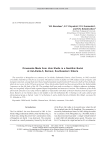
Ornaments Made from Unio Shells in a Neolithic Burial at Ust-Aleika-5, Barnaul, Southwestern Siberia
Статья научная
The search for a Mongolian era cemetery at Ust-Aleika, Kalmansky District, Altai Territory, in 1982 revealed a Neolithic child burial, which was excavated. The funerary items included over 300 artifacts made of organic and inorganic materials, among them more than a hundred pendants made from fossil Pleistocene shells of Unio mollusks, which do not occur in the Ob basin at present. These thick-walled shells had been procured from the Kalistratikha I exposure on the left bank of the Ob. The pendants had been made according to a hitherto unknown technique: they are irregularly ellipsoid with segment-shaped longitudinal and transverse sections. The thickness of the shells allowed the artisans to use relief, which is diffi cult or impossible with shells of modern bivalves from the Upper Ob basin. Burial 2 at Ust-Aleika-2 dates to the middle or late 4th millennium BC. It belongs to the same cultural and chronological group as burials 1 and 5–9 at Solontsy-5, and a double burial at Bolshoi Mys (Itkul), excavated by V.I. Molodin in 1976.
Бесплатно
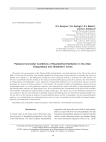
Статья научная
We explore the environments of the Sibiryachikha Neanderthals, who had migrated to the Altai at the end of MIS 4. Given that the territory was already populated by Denisovans, the key question is whether the choice of habitat was random (i.e., the immigrants occupied vacant ecological niches) or motivated by other factors. On the basis of published results relating to the study of small-mammal fauna and pollen analysis, the environments of Chagyrskaya and Okladnikov Caves during the Neanderthal habitation are reconstructed. Species of small mammals are viewed as biome members. To reconstruct the episodic transfer of mammalian remains between stratigraphic units, we used ordination statistics and compared the results with those of micromorphological and stratigraphic analyses of Chagyrskaya Cave. It was found that late Neanderthals of the Altai lived in similar environments, dominated by steppe and forest steppe landscapes. The choice of caves for habitation depended on several factors, the key ones being the availability of game and high-quality raw material for manufacturing tools. On the basis of the statistical analysis of small-mammal fauna and the stratigraphic and micromorphological analyses, we conclude that post-sedimentation processes in caves can include vertical transfer of animal remains, affecting environmental reconstructions.
Бесплатно
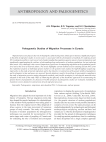
Paleogenetic studies of migration processes in Eurasia
Статья научная
Migration processes played a key role in shaping the cultural and genetic landscapes in Eurasia. Significant progress in the field of migration studies in recent years is associated with the development of methods for studying ancient DNA, making it possible to reach a new level of understanding the population-genetic aspects of ancient migrations and significantly supplementing the evidence of paleoanthropology and genetics of modern populations, but not replacing these areas. A key challenge is the correct comparison of processes accompanying migrations at the population genetic level and at the level of material culture. The article highlights current methods used in studying ancient DNA, from the traditional analysis of individual genetic markers to the genome-wide analysis by high-throughput sequencing. Approaches to the study of ancient migrations and to the objective reconstruction of the genetic profile of populations and its dynamics in time and space are assessed. Special attention is paid to the problem of representative sampling in the study of migration processes using paleogenetic methods, and possible strategies for selecting the materials most adequate to the tasks of the study. Ways of enhancing the efficiency of the diachronic approach in reconstructing the genetic history of populations are discussed. Possible prospects of paleogenetic studies are evaluated, including the transition to more detailed reconstructions of local migration processes.
Бесплатно

